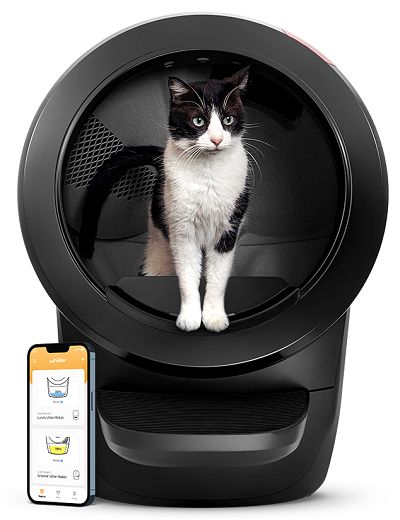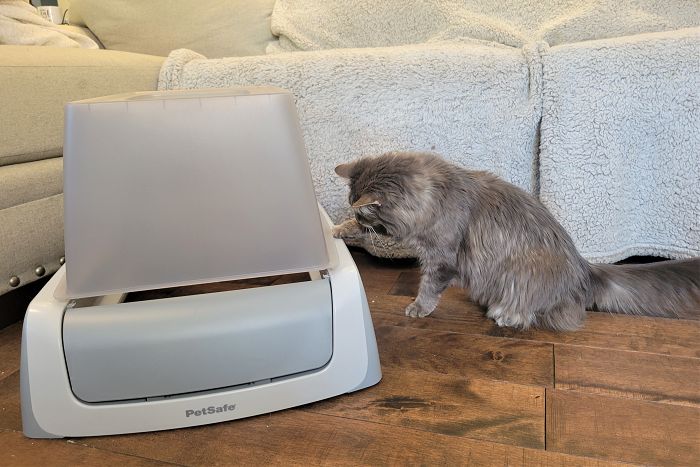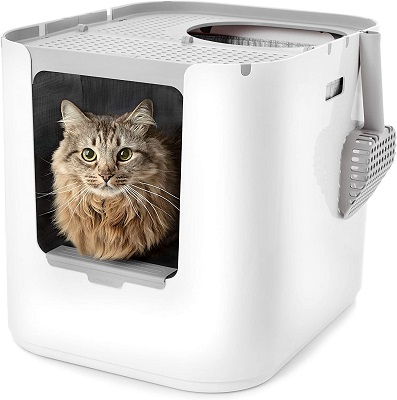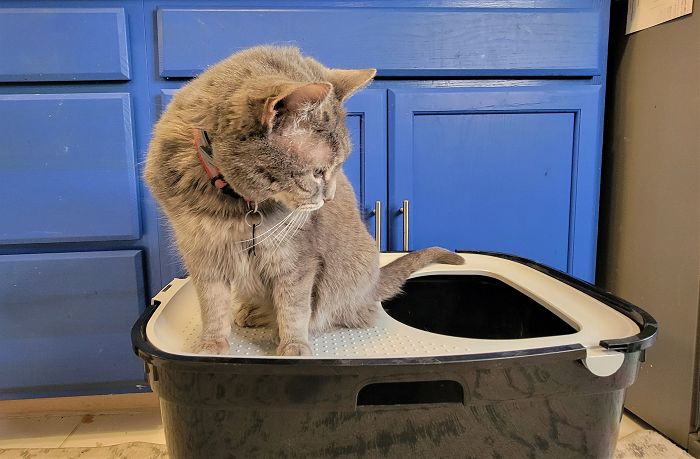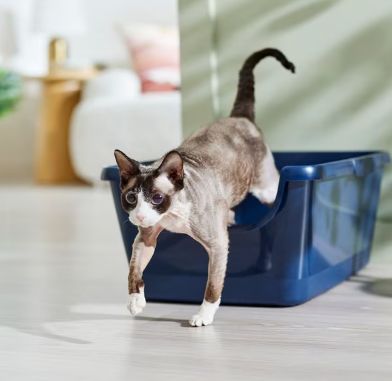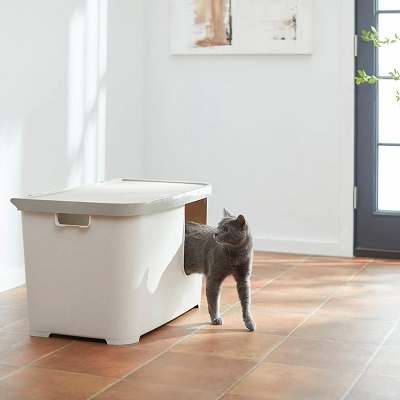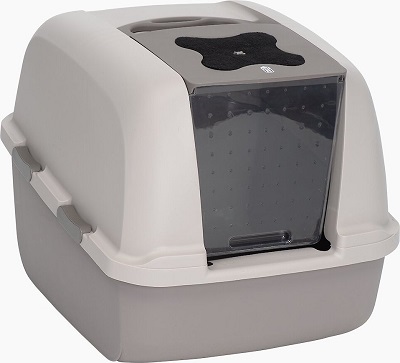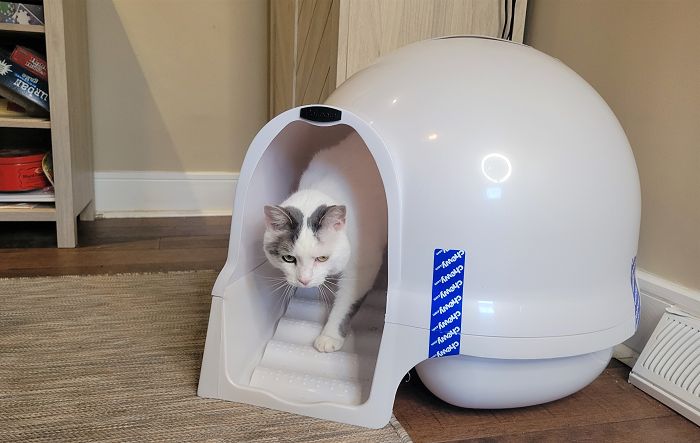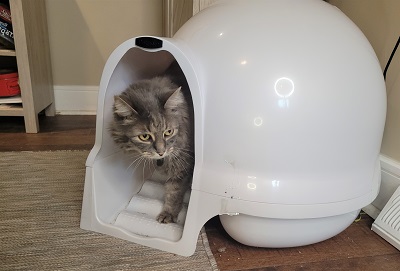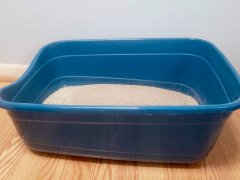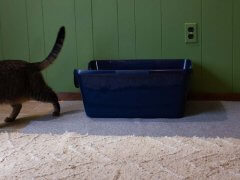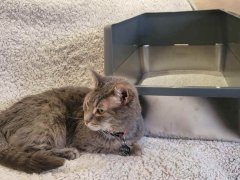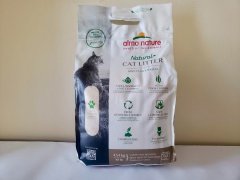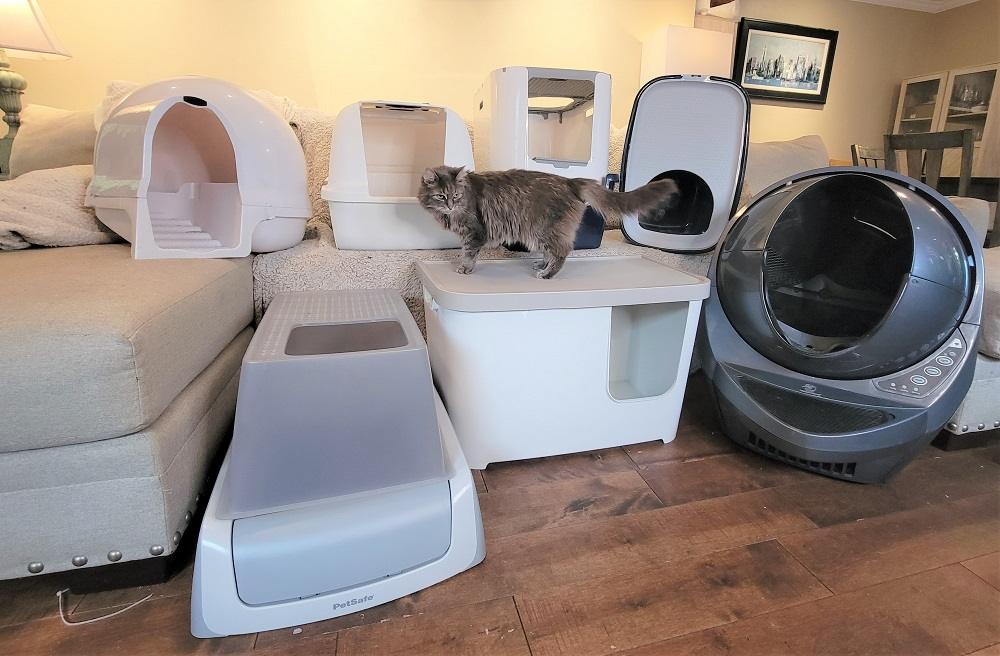
Kate Barrington / Cats.com
Though cat poop smells unpleasant to human noses, to some dogs, it smells like food. If your dog finds it hard to resist the tasty treats in your cat’s litter box, you might need to change the game by buying a dog-proof cat litter box.
Few litter boxes are completely dog-proof for the most single-minded snackers, but high sides, top-entry designs, and automatic cleaning features can help keep dogs out.
I’ve chosen the Litter-Robot 4 as the best dog-proof cat litter box on the market. Its impressive performance and smart features make it a standout choice for cats and cat owners alike, but it’s also got a few tricks up its sleeve when it comes to deterring dogs.
But a pricey pick like the Litter-Robot isn’t the right choice for every household. That’s why we’ve selected a total of 8 top recommendations that run the gamut from automatic, self-cleaning models to standard open litter pans.
In addition to reading about our favorite dog-proof litter boxes in this article, you’ll learn what design qualities and features are the most effective in keeping dogs out and cat litter in.
At a Glance: 8 Best Dog-Proof Litter Boxes




In the comparison table below, we’ve highlighted some of the most important features of each product. You’ll find more detailed information about each product later in the article.
Litter-Robot 4 Automatic Litter Box
- Robust design and reliable performance
- Keeps waste hidden away
- Can be used with any clumping litter
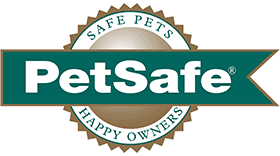
PetSafe ScoopFree with Top-Entry
- Reliable, not prone to jamming
- Easy to set up and operate
- Rakes waste into a covered compartment

Modkat XL Top-Entry Litter Box
- Modern and functional design
- Top entry keeps out smaller dogs
- Reusable liner for easy cleanup

Frisco Top Entry Cat Litter Box Large
- Top entry keeps smaller dogs out
- Flip-top lid for easy scooping
- Strong odor control ability

Frisco High-Sided Cat Litter Box Extra-Large
- Generously sized litter bed
- High sides help keep small dogs out
- Affordably priced around $20

Frisco Multi-Function Covered Cat Litter Box
- May deter bigger dogs
- Top flips up for easy scooping
- Included litter scoop and caddy

Catit Jumbo Hooded Cat Litter Pan
- May be good for bigger cats
- Clear door that flips out of the way
- Large opening for easy scooping

Petmate Booda Dome Cleanstep Cat Litter Box
- Ramp entry for easy access
- Minimizes tracking and scatter
- Built-in handle for easy carry
Why Should You Trust Us?
Over the last several years, we’ve spent a lot of time researching the factors that make a litter box great. We’ve researched the different types of litter boxes on the market, scoured customer reviews, and performed in-home tests on dozens of options.
In addition to research and real-world testing, we consulted with veterinarians to determine what it takes to keep a dog out of the litter box without negatively impacting its cat-friendliness.
What To Look For in a Dog-Proof Litter Box
Coprophagia, the scientific term for eating feces, is a natural behavior for dogs in certain situations. To keep the nesting area clean, nursing mothers sometimes consume their pups’ feces. Puppies sometimes mimic this behavior, though most grow out of it once they discover that food tastes much better.
But why do some adult dogs eat cat poop straight from the litter box? And should you be worried about it?
Dog breath is bad enough, but snacking from the little box ups the grossness factor. Eating cat poop also comes with the potential to expose your dog to harmful bacteria and parasites – some of which can be transmitted to humans, like toxoplasmosis or salmonella. The bits of cat litter a dog might consume along with the feces can be problematic as well.
Changing your litter box could be the key to keeping your dog out. Here’s what to look for when shopping for a dog-proof litter box.
High Sides
Basic litter pans have short walls which enable your cat to access the box from all sides. With no barrier to entry, however, these litter boxes offer optimal snacking opportunities for your dog. High sides make it a little bit harder for your dog to get at the goodies inside the box.
Most high-sided litter boxes have lower entry points for cat accessibility. This might be enough for some dogs to reach in, so you may need to combine a high-sided litter box with other solutions.
Cover
Enclosed or covered litter boxes may be more effective against large dogs than high-sided boxes. The entry should be big enough for your cat to comfortably come and go but small enough that your dog won’t be tempted to stick their head in.
While covered litter boxes are great for odor and scatter control, some cats dislike the feeling of being confined while they do their business. Translucent tops and clear doors may help mitigate this concern.
Top-Entry Design
Top-entry litter boxes combine the security of a covered litter box with high dog-stopping sides. Rather than stepping into the litter box, your cat drops down through an opening in the lid.
This type of litter box is most likely to deter small dogs who can’t reach the opening, but large dogs may be tall enough to poke their heads in.
Consider the interior space when selecting a top-entry litter box, as these tend to be more confining than open-style litter pans. Big breeds like Maine Coons may find top-entry litter boxes uncomfortable.
Automatic Cleaning
An automatic, self-cleaning litter box scoops the poop and stores it away where your dog can’t get to it. It’s a win-win situation for you, considering it saves you the hassle of cleaning the litter box yourself.
The downside of automatic litter boxes is that they tend to be expensive. Some models are more dog-proof than others as well, so think about the mode and height of entry to limit your dog’s access.
Models like the Litter-Robot 4 enable automatic cleaning immediately following your cat’s exit, and you’re able to adjust the cycle timer to decide how long it’ll wait to clean after use. The longer the delay before cleaning, the more opportunity your dog will have to sneak in and steal a snack.
Remember to consider your cat’s preferences.
Ultimately, the best way to prevent your dog from eating cat poop is to scoop the litter box before it becomes an issue. Should your dog be particularly persistent, however, consider your cat’s preferences when shopping for a new litter box.
Top-entry litter boxes and models with high sides can be a challenge for kittens and older cats – especially those suffering from arthritis. Some cats feel claustrophobic in covered litter boxes while others find the added privacy comforting. Automatic litter boxes can scare skittish cats with their sound and movement, though they’re hard to beat when it comes to keeping things clean.
Thoughtful litter box placement can help limit your dog’s access as well. A baby gate raised a few inches off the floor will keep your dog at bay while your cat can slink underneath. Or place the litter box on a table or another piece of furniture to keep it out of your dog’s reach.
Just make sure you don’t make it needlessly difficult for your cat to get into the box themselves or you may find yourself dealing with another problem: litter box avoidance.
